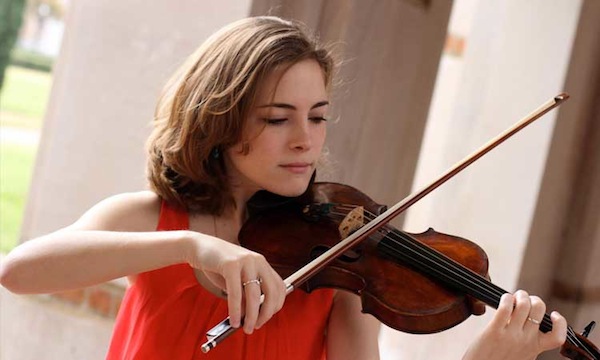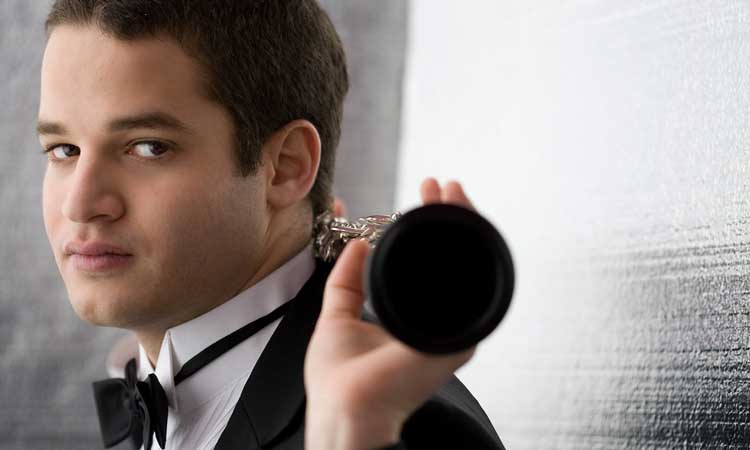New World members shine in the solo spotlight
For sheer entertainment value, few events on the concert calendar beat the New World Symphony’s annual “Concerto Showcase” concerts.
At these events, New World musicians stand before the orchestra to perform solo works. The concerts typically yield solo performances on instruments other than the violin and piano that dominate the concerto repertory. And they allow audiences to hear rarely performed works, as the young musicians often display more imagination in their choice of music than many of the celebrity soloists that come through South Florida.
Saturday night’s concert at New World Center in Miami Beach, delivered the goods, with polished, professional-level performances under the leadership of guest conductor Ward Stare, music director of the Rochester Philharmonic.
Mozart composed his Violin Concerto No. 5, known as the “Turkish,” at the age of just 19, and Saturday, for once, it really sounded like it. The concerto’s youthful freshness doesn’t come through in every performance, but it did in the hands of Rebecca Reale. Playing a 1740 Guarneri del Gesu lent to her by Florian Leonhard Fine Violins of New York, she gave a virtually flawless performance that brought out the work’s high spirits and abundance of melody.
Virtuosity on the violin is often seen as a matter of scorching runs up the fingerboard, the bow bouncing around at high speed, multiple notes played at once. Less flashy but no less difficult is to play Mozart with the grace, style and accuracy Reale displayed Saturday. With expert bow control and dead-on intonation, she played the first movement in an effortless manner that expressed its essential lightness.
The pathos of the second movement came through, with its passionate descending trill passages, performed by Reale with restraint that still allowed the emotion to come through. Although she played with ample vibrato, she kept the performance within Classical proportions. Her playing of the famous “Turkish” section of the last movement, with its minor-key runs over a drone in the orchestra, could have used more bite, particularly next to the orchestra’s thumping earthiness. But this the only quibble in a performance that did justice to a great and underperformed work.
The most unusual piece on the program was the Clarinet Concerto of Carl Nielsen. Denmark’s greatest composer lived from 1865 to 1931, with a working life that spanned music’s late Romantic and early Modern periods. The Clarinet Concerto, composed in 1928, is decidedly 20th-century in sensibility, with a sardonic opening theme that could have come from Shostakovich or Prokofiev.
The concerto is considered one of the most difficult in the clarinet repertory, with lightning sequences of notes, rapid staccato passages and shifting moods that require the performer to play with lyric warmth one moment and baleful power the next.
Clarinetist Ran Kampel not only displayed a mastery of the work’s most difficult passages but pulled them off with style, injecting them with a sizzle of excitement. In his tone, he showed a great range–rounded, warm and even in lyric passages, eerie through much of the work and in one passage, sounding like the edge of a howling wind, as he pierced the thunder of the orchestra.
Austin Fisher is already a New World alum, having been hired last month as assistant principal cello of the Colorado Symphony Orchestra.
The cellist’s rich tone could have been made for Schumann’s Cello Concerto. He gave a big-hearted, virtuosic performance of this work, using his smooth bowing and warm vibrato to wring the most emotion from Schumann’s melodies without ever overdoing it.
During an introductory video, he said he felt especially close to the second movement, and this affinity showed in the performance. Although capable of a big, throbbing cello tone, he never used it to overwhelm Schumann’s delicate melodies, using his smooth bow arm to play them with refinement and style. His virtuoso chops were clear in the last movement, as he deftly handled rapid passages and the playing of two notes at once, all in tune and energetic.
Under Stare’s leadership, the orchestra generally provided firm, sensitive support to the soloists, especially in the Nielsen, where the ensemble created a mysterious halo of sound around the clarinet. In the first movement of the Mozart, textures were light and transparent, but the sound often felt too small and thin, especially for such an extroverted work. In the Schumann, however, the tuttis were appropriately passionate and grandiose, with the orchestra scaling back for the cello in a manner that never overwhelmed the soloist.
The concert opened with a tight, dramatic and tension-filled performance of Beethoven’s Fidelio Overture.
The New World Symphony will repeat the program 2 p.m. Sunday at New World Center in Miami Beach. nws.edu; 305-673-3331.
Posted in Performances
Leave a Comment
Sun Feb 21, 2016
at 1:45 pm
No Comments


